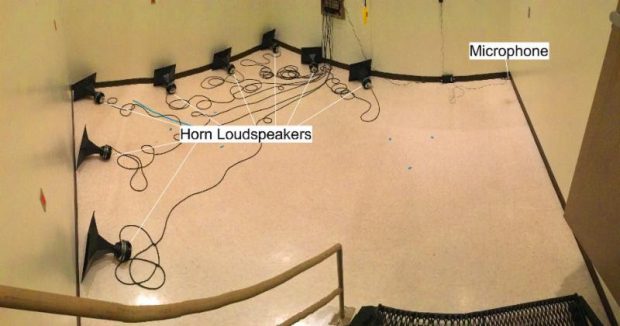
The experimental setup with eight horn loudspeakers and a microphone positioned inside the reverberation chamber. Image courtesy of Spectrum Instrumentation.
September 19, 2018
The Acoustics Research Group at the Department of Physics and Astronomy, Brigham Young University, is researching the use of time reversal (TR) signal processing to focus waves sound with high amplitudes in a room. TR focuses waves to a selected location that converge from all directions to produce a virtual source of spherical waves and then diverge from that location. To generate the acoustic waves and capture the results, Brigham Young University use Arbitrary Waveform Generator (AWG) cards and a digitizer card from Spectrum Instrumentation.
 The experimental setup with eight horn loudspeakers and a microphone positioned inside the reverberation chamber. Image courtesy of Spectrum Instrumentation.
The experimental setup with eight horn loudspeakers and a microphone positioned inside the reverberation chamber. Image courtesy of Spectrum Instrumentation.“I have looked into using many different types of generation and acquisition cards and determined that Spectrum cards offer the most cost-effective solution for the ultrasonic frequency range of interest to us,” says Brian Anderson, associate professor at Brigham Young University (BYU). “The combination of multiple channels, synchronous generation and acquisition, and high sampling frequencies were ideal for our work in the development of ultrasonic non-destructive evaluation techniques. We have also used these cards for non-linear acoustics measurements of sound in rooms where the high sampling frequencies allowed us to characterize the steep waveforms we encountered.”
The experiments at BYU create a high amplitude focus of sound in a reverberation chamber. The TR signal processing method focuses sound waves from remotely placed sources using a forward and backward step. During the forward step, an impulse response (or transfer function in the frequency domain) is obtained for a source and a receiver. The impulse response is then reversed in time and, if required, additional processing can be applied. During the backward step, the reversed impulse response is broadcast from the source and focusing of sound is achieved at the receiver location.
To achieve high focal amplitude, an experimental setup was designed that consisted of eight coaxial compression drivers with horns attached. One GRAS free-field microphone with a specified dynamic range upper limit of 175 dB was used in conjunction with a preamplifier for the measurements.
The signals used for the experiments are created in MATLAB and output via two, 4-channel Spectrum M2i.6022-exp 20 MS/s AWG cards. The output from the Spectrum AWG is amplified with two, 4-channel Crown CT4150 amplifiers. The signal acquisition from the microphone is done with one, 4-channel Spectrum M2i.4931-exp 16-bit digitizer card running with a sampling frequency of 50 kHz.
The university studies found that, to produce the highest amplitude focus of sound, the best impulse response modification method was achieved by using a technique known as the clipping method. In this experiment, an optimal clipping threshold of 9.05 kPa (173.1 dB peak) was achieved. Experiments, conducted at lower amplitudes and scaled appropriately to the highest amplitude result, provide evidence that TR focusing at these high amplitudes is a nonlinear process.
The ability to focus waves offers interesting possibilities in a number of fields such as communications, ultrasound, nondestructive testing (NDT), medical science and audio. For example, in biomedical applications, focused ultrasound can be used in lithotripsy procedures for treating kidney stones or to target brain tumors. Similarly, in NDT, the TR process has been used to help locate and characterize defects in solid materials. In addition, it can be used to create high amplitude focusing of ultrasound for a noncontact source used for non-destructive evaluation.
Prices for the M2i.6022-exp start from $5,090 and from $4,730 for the M2i.4931-exp.
For more info, visit Spectrum Instrumentation.
Sources: Press materials received from the company.
Subscribe to our FREE magazine, FREE email newsletters or both!
About the Author
DE’s editors contribute news and new product announcements to Digital Engineering.
Press releases may be sent to them via [email protected].





